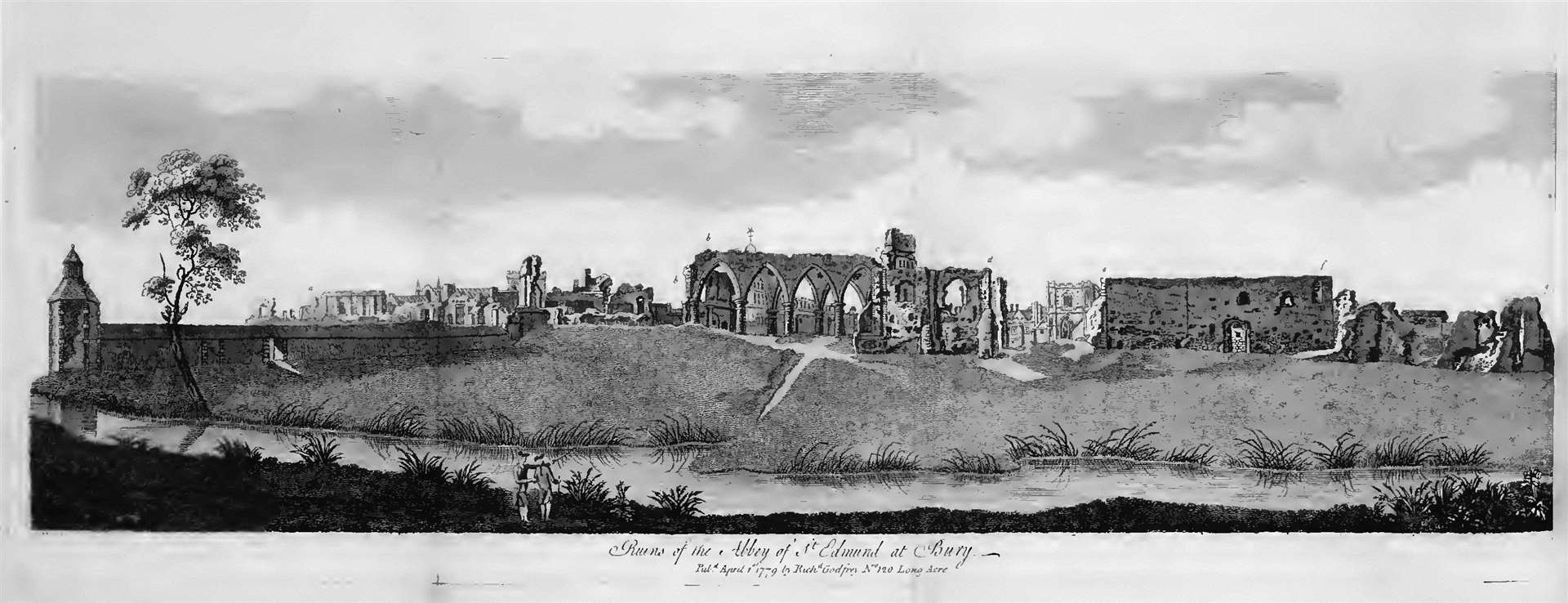History and Archaeology
Little is known about the early history of the abbey, but archaeological evidence shows that there was an Anglo-Saxon settlement on this site, and later documents say that it was called Beodricsworth.

Godfrey’s view of the northern half of the precinct, Grose’s Antiquarian Repertory 1779
In AD 869, Edmund, King of the East Angles, was killed by the Danes and within a few decades his body was laid in a timber church at Beodricsworth. Possession of Edmund’s body led to the later Benedictine Abbey becoming one of the wealthiest and most powerful monasteries in England and one of the major pilgrimage sites in western Europe. It led to the town being called Bury St Edmunds.
The royal veneration of Edmund was bound up with the origins and legitimacy of English kingship and so his shrine was strongly supported by medieval rulers. In around AD 1020, under the patronage of King Canute, the shrine at Bury St Edmunds was refounded as a Benedictine monastery. Every English King between William I and Henry VII visited the abbey and several parliaments were held here.
Throughout the medieval period, the abbey was an important stage on which regional and national politics were played out. Perhaps the most celebrated occasion was in 1214, when it is thought that a meeting of earls and barons at the abbey led to Magna Carta.
St Edmund gave the town its name and the town grew up in the shadow of the abbey. The abbots laid out the streets and controlled the town and the surrounding area. Relations between town and abbey were often tense, occasionally erupting into riots as in 1327 when the abbey gate was burnt down and in 1381 when the Prior was killed.
After the dissolution of the abbey in 1539, the buildings were demolished. Medieval dressed stone from the abbey can still be seen in many walls and houses around the town. The body of St Edmund was taken from its shrine and there is some speculation that it may possibly be buried in the abbey grounds.
Recent research demonstrates that the nature and extent of the buried archaeology and the discoveries during the last few centuries far exceed those of many other monastic sites, even if the surviving ruins are less extensive. The site is overlain by demolition rubble, which preserves much of the archaeology beneath. Over 100 individual episodes of archaeological or antiquarian investigation have been identified, which is far higher than was first expected. Many of the archaeological investigations have been piecemeal and the abbey precinct has not been systematically investigated.
Perhaps the most famous of these excavations occurred after M.R. James, scholar, antiquarian and writer of ghost stories, found manuscript evidence that six of the abbots were buried in the chapterhouse of the monastery. On New Year’s Day 1903, the tombs were found exactly where he predicted they would be. The graves can be seen in the ruins and finds from the tombs are still exhibited in Moyse’s Hall Museum.
Archaeological investigation has produced evidence of prehistoric occupation of the area, although, interestingly, none of Roman occupation. There is strong evidence to suggest an Anglo-Saxon settlement underlies the medieval abbey buildings and deep layers of demolition rubble. Despite all the historical and archaeological investigations of the abbey that have taken place, an enormous amount remains to be discovered
